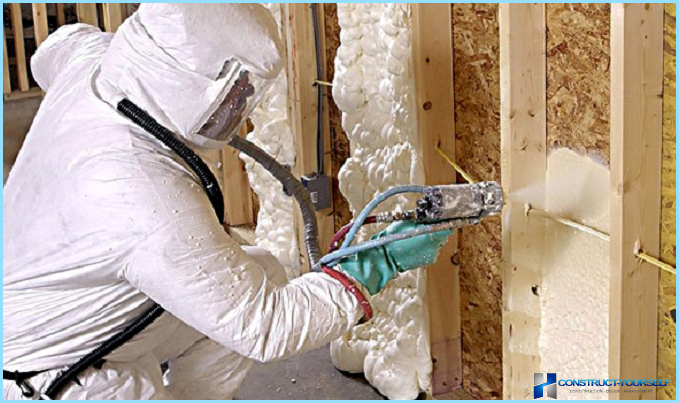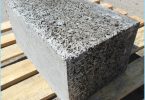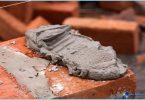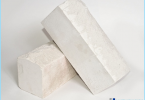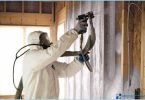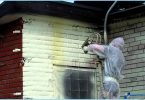The contents
A relatively new insulation technology using converted into a foamy condition of the polyurethane appeared in the expanses of the former Soviet Union a relatively long time, more than two decades ago, and immediately announced himself as a simple and powerful method of home insulation. The composition and nature of the new material few people interested, the main thing was the comfort of the process of insulation of polyurethane foam, in comparison with the threat-made glass Mat, or capricious brittle foam.
The best choice of material for insulation ↑
By its nature, foam materials, ceramic, polymer or a different nature, no matter is the most effective insulator. The foam insulation of household question on the effectiveness is second only to the multilayer heat-reflective coating that is ten times more expensive.
Foam the polymer foam has a number of advantages:
- Very low thermal conductivity of the solidified mass, and hence effective and inexpensive insulation surface;
- The relative harmlessness of cured foam;
- Good workability and high adhesion – ability to stick to materials of construction, performance characteristics -50onC to + 60onWith no loss of basic properties.
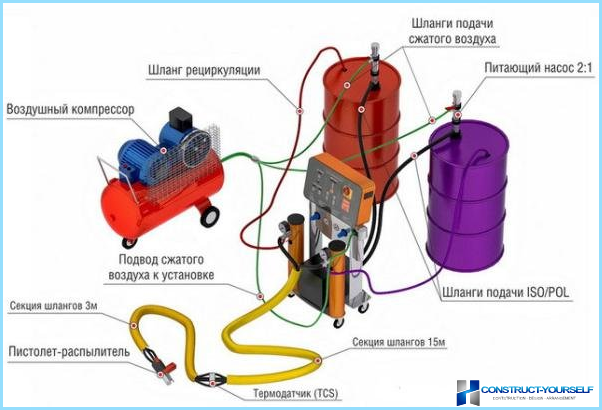
Even in low temperatures, due to the large number of closed pores, the polymer foam maintains insulating properties. Similar material in slightly modified form is used in the insulation of tanks with liquefied methane on ships.
The classic recipe involves the preparation of a polymeric foam by mixing two reagents, one of which is alcohol or glycol ether, the second isocyanate. Thanks to him, in the foamed mixture of the urethane appear when fixing the formed bubbles, which add rigidity to the resulting bubble mass.
Components are mixed in the spray device and are ejected through the nozzle onto the surface. Dissolved in a mixture of gas, usually freon or butane, churns zagusteniya ground in easy bubble foam.
Practical insulation with PUF with his own hands ^ a
Often we are faced with the components of the polymer Packed in liter bottles, often issued as a foam semi-professional level of work. From one bottle you can get up to 7 liters of hardened foam material. Typically, the insulating layer does not exceed 4-5 cm, one or two cylinders is enough for insulation using polyurethane foam of a water or heating pipes, but no more.
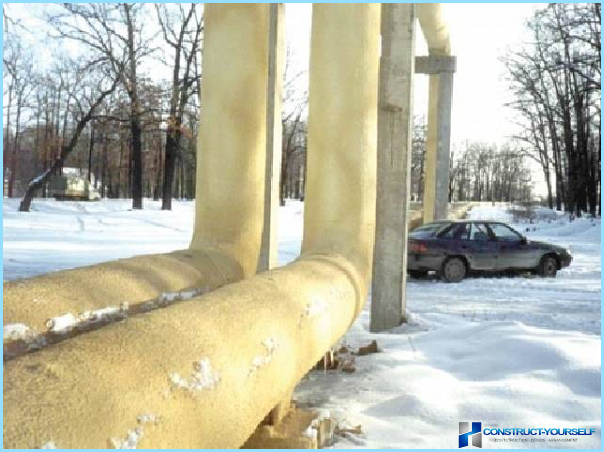
If you want «blow out» foam large enough surface to use a more powerful portable machine that allows you to work with insulation of tens of square meters. Based installation:
- Two containers with the original components of the foam;
- dispenser with mixing device and the hose;
- feeding device – an air compressor or compressed gas cylinders.
The polymerization reaction takes place with absorption of air water vapor, for a normal reaction in dry hot weather the surface to be treated even pre-moistened with clean water. In addition, prior to insulation of any surface it should be thoroughly cleaned of dust, old paint and dirt, otherwise the foam layer may simply fall off due to poor adhesion.
The easiest way to do the insulation using polyurethane foam in closed cavities, vessels and ducts, which are very lightweight foamed polymer is not affected by draughts or gusts of wind, able to tear or deform a layer of foam.
For the first few minutes on the surface of the foam material is a thin crust and intensely stand out bubbles of carbon dioxide. After 7-10 minutes, the foam layer of the foam begins to solidify and take shape in the form of insulation.
The process of applying the foam layer, as a rule, begin from the bottom up of successive horizontal passages with a constant speed jet atomizer.
Powerful jet spray can shoot down light uncured foam. Better to wait for curing of the foam, and re-processing to correct the defect.
If insulation is required, apply a layer of more than 4 cm thick on a vertical surface or plane with a negative slope, it is possible to use a polymer mesh construction, commonly used as a reinforcing framework for plastering and finishing works. Usually it is fixed at a distance of 2.5-3 cm from the surface of the insulation. This would prevent dumping the bulk of the foam under the influence of air flow.
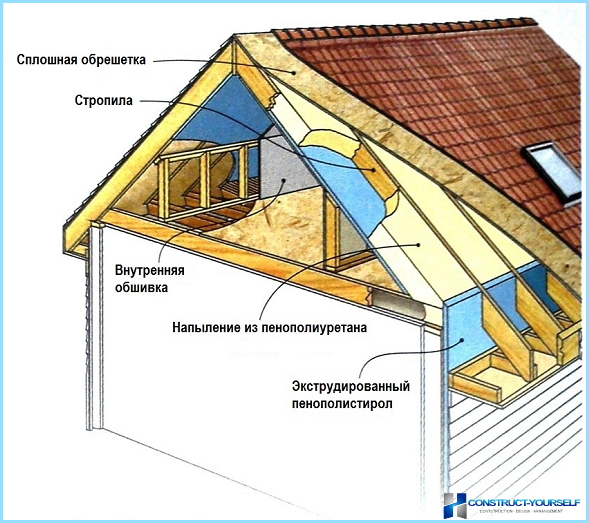
When mixing the components is allocated a certain amount of heat, so spray nozzle and mixing chamber can heat up to 90-100onC. Further work on the insulation using polyurethane foam, you must stop to cool the tool. The optimum temperature of operation are considered 25-27onWith them in the winter time bottles of liquid reactants is heated with hot water or air in the heat – pour cold water.
If you operate at excessively high temperatures, foam polyurethane foam is too airy and fragile, can easily fall off the surface of the insulation. At low temperatures the polymer will be too dense, with low levels of insulation.
If the interruption of the spray installation is expected to more than 1 hour, the nozzle and the mixing chamber must be cleaned from the remnants of the components. You can use a proprietary cleaner, but most of the sink perform a mixture of acetone to isopropyl alcohol.
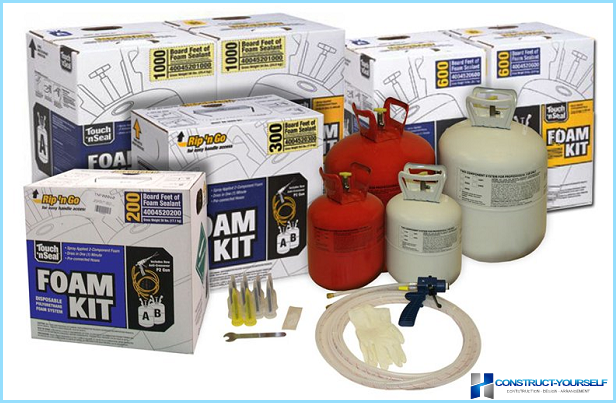
Features of the use of foamed polyurethane ↑
The main task of insulation is the proper selection of grade of foamed polyurethane. There are several major brands of foamed polymer foam:
- Lightweight foam, the specific weight of 9-10kg on the cube has large number of pores, but almost 80% of them open, with a large diameter. For insulation of large surfaces fits badly, as has the high conductivity and low strength. More used for the sound insulation works;
- Hard foamed polyurethane with a specific gravity four-five times more lightweight foam. The cells and the pores are small, the vast majority of closed from the environment. The thermal conductivity and durability about twice of the easy options FPU. Well suited for insulation of any building structures, even with high vibration loads;
- Foam-medium grade – lighter than hard foamed polyurethane. Apply for domestic work in the insulation or mounting a variety of building structures from polypropylene, wood, metal sheets.
In the works on warming of walls and roofs with their own hands often use the last version of PPU. For spray applied automotive or construction of the compressor simple design of the spray gun. The effectiveness of this insulation is approximately 10% below the industrial methods of insulation with polyurethane foam.
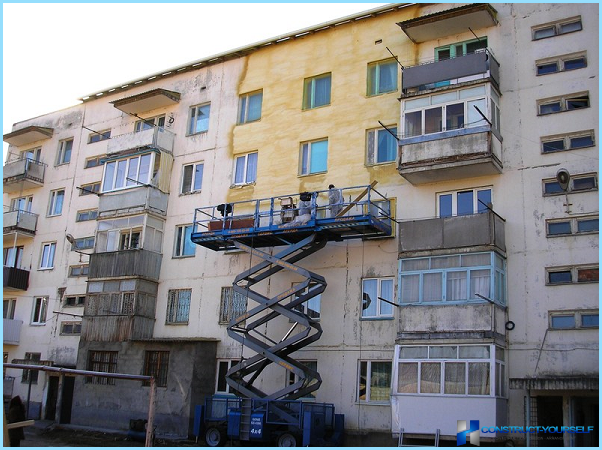
In professional settings using heavy grades of foam gas pressure, the spray mixture often reaches hundreds of atmospheres, allowing you to get unprecedented quality of adhesion to the surface and cover at the same time a spray pattern area of 0.5 mTwo.
However, services for the insulation professional team will cost about the cost of the materials for forming the protective layer foam.
Negative aspects of using foamed polymer ↑
Most brands of foam have additives that prevent combustion. But this does not mean that the polymer is completely safe from fires. Like any organic substance, high temperature foam emits large amounts of toxic gases, which often suffer in the fires.
The second downside is the intense destruction of the polymer under the influence of solar radiation. Often loss qualities of polyurethane foam enough material stays in the sun for a couple of weeks. Therefore, the insulating layer must be closed with plastic sheet or fiberboard.
The worst sin in the conduct of works on application layer of foamed polyurethane is a violation of the proportions of the components used. If the mixing chamber and the flow rate are not set correctly, for example, with excess isocyanate, the foam will be very fragile and hard. With its lack will get the opposite effect – foamed polymer hardens, it will be soft and will gradually lose the bubble structure.
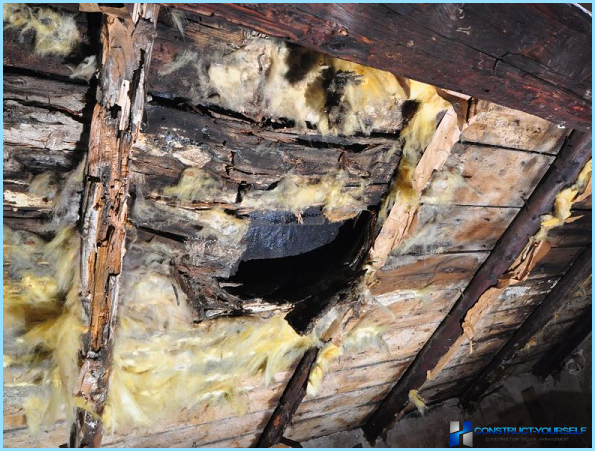
Conclusion, or how to work with the PPU ↑
For those who need to carry significant amounts of insulation using polyurethane foam, useful video, which demonstrates a lot of trade secrets work. This will help to choose the right contractors to perform work, respectively, to compare their quality of work demonstrated in the video.
The risk of carelessly applying foamed PUF is very large, primarily because of the uncontrolled use of the workers the cheapest grades of foam under the guise of expensive and high quality brands.

